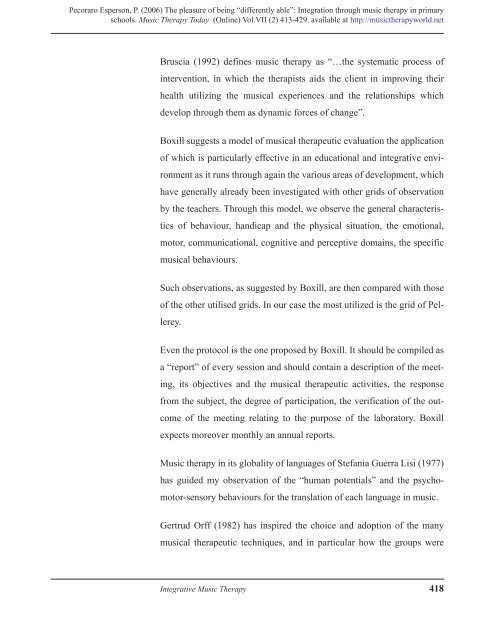Music Therapy Today - World Federation of Music Therapy
Music Therapy Today - World Federation of Music Therapy
Music Therapy Today - World Federation of Music Therapy
You also want an ePaper? Increase the reach of your titles
YUMPU automatically turns print PDFs into web optimized ePapers that Google loves.
Pecoraro Esperson, P. (2006) The pleasure <strong>of</strong> being “differently able”: Integration through music therapy in primary<br />
schools. <strong>Music</strong> <strong>Therapy</strong> <strong>Today</strong> (Online) Vol.VII (2) 413-429. available at http://musictherapyworld.net<br />
Bruscia (1992) defines music therapy as “…the systematic process <strong>of</strong><br />
intervention, in which the therapists aids the client in improving their<br />
health utilizing the musical experiences and the relationships which<br />
develop through them as dynamic forces <strong>of</strong> change”.<br />
Boxill suggests a model <strong>of</strong> musical therapeutic evaluation the application<br />
<strong>of</strong> which is particularly effective in an educational and integrative envi-<br />
ronment as it runs through again the various areas <strong>of</strong> development, which<br />
have generally already been investigated with other grids <strong>of</strong> observation<br />
by the teachers. Through this model, we observe the general characteris-<br />
tics <strong>of</strong> behaviour, handicap and the physical situation, the emotional,<br />
motor, communicational, cognitive and perceptive domains, the specific<br />
musical behaviours.<br />
Such observations, as suggested by Boxill, are then compared with those<br />
<strong>of</strong> the other utilised grids. In our case the most utilized is the grid <strong>of</strong> Pel-<br />
lerey.<br />
Even the protocol is the one proposed by Boxill. It should be compiled as<br />
a “report” <strong>of</strong> every session and should contain a description <strong>of</strong> the meet-<br />
ing, its objectives and the musical therapeutic activities, the response<br />
from the subject, the degree <strong>of</strong> participation, the verification <strong>of</strong> the out-<br />
come <strong>of</strong> the meeting relating to the purpose <strong>of</strong> the laboratory. Boxill<br />
expects moreover monthly an annual reports.<br />
<strong>Music</strong> therapy in its globality <strong>of</strong> languages <strong>of</strong> Stefania Guerra Lisi (1977)<br />
has guided my observation <strong>of</strong> the “human potentials” and the psycho-<br />
motor-sensory behaviours for the translation <strong>of</strong> each language in music.<br />
Gertrud Orff (1982) has inspired the choice and adoption <strong>of</strong> the many<br />
musical therapeutic techniques, and in particular how the groups were<br />
Integrative <strong>Music</strong> <strong>Therapy</strong> 418

















